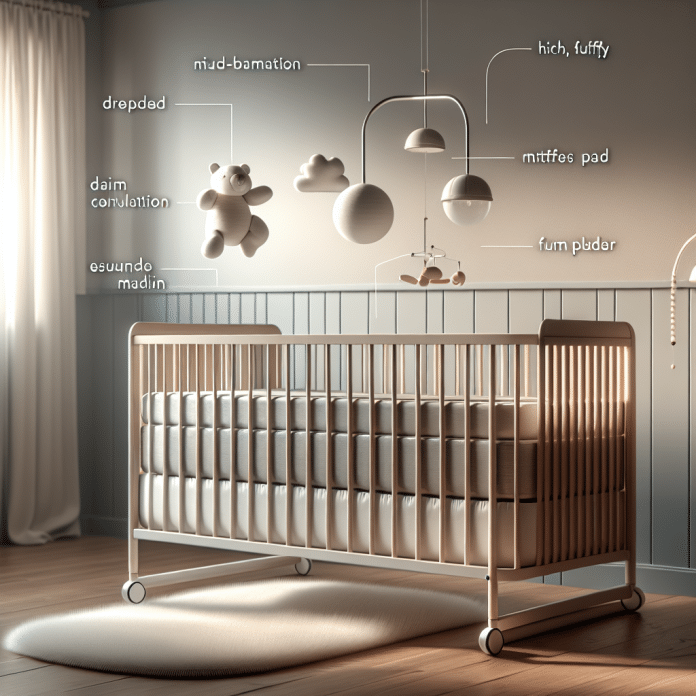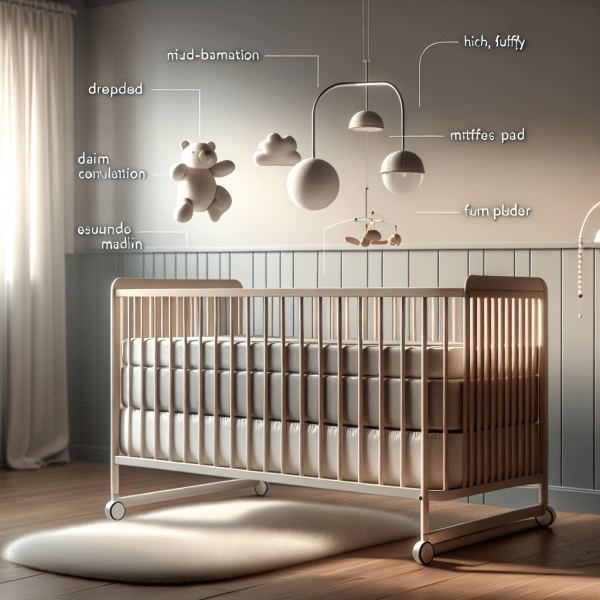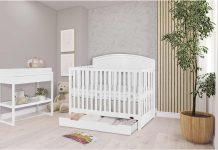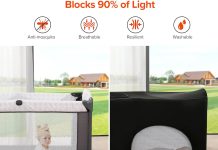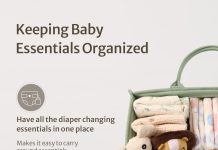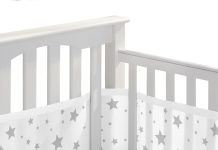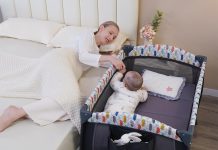If you’re a new parent, chances are you’re constantly on the lookout for ways to make your precious newborn’s sleep as comfortable as possible. One question that often arises is whether it’s safe to use thick mattress pads for newborns. After all, a little extra cushioning can seem like a good idea, but safety is always of the utmost importance. In this article, we’ll explore the safety considerations of using thick mattress pads for newborns, so you can make an informed decision and ensure a cozy and secure sleep environment for your little bundle of joy. When it comes to providing a comfortable and safe sleeping environment for your newborn, there are many factors to consider. One of these factors is the type of mattress pad you choose for your baby’s crib. Mattress pads can provide cushioning and protection for the mattress, but it’s important to understand the potential risks associated with thick mattress pads for newborns. In this article, we will explore these risks and discuss safe alternatives to consider. We will also provide some helpful tips for choosing a suitable mattress pad for your newborn and highlight the importance of safe sleeping practices. Finally, we will emphasize the value of consulting with pediatricians to ensure your baby’s sleep safety.
Factors to Consider with Mattress Pads
Review contents
Material Composition
The material composition of a mattress pad can greatly impact your baby’s comfort and safety. It is important to choose a pad that is made of high-quality, breathable materials. Natural fibers, such as cotton or bamboo, are often a good choice as they are hypoallergenic and gentle on your baby’s skin. Avoid materials that are too synthetic or have a strong chemical odor, as these can potentially irritate your baby’s delicate respiratory system.
Size and Fit
Another important factor to consider is the size and fit of the mattress pad. It should fit snugly on the crib mattress without any loose fabric that can potentially pose a suffocation hazard. Make sure to measure your baby’s crib mattress accurately and choose a pad that matches the dimensions. A well-fitting mattress pad will provide a smooth and supportive surface for your baby to sleep on.
Breathability
Breathability is crucial for your baby’s safety while sleeping. Thick mattress pads can hinder proper airflow, which can increase the risk of overheating or suffocation. Look for mattress pads that are specifically designed to be breathable, allowing air to circulate freely. This will help regulate your baby’s body temperature and reduce the risk of Sudden Infant Death Syndrome (SIDS).
Hypoallergenic Properties
Babies have delicate skin and are more prone to allergies and sensitivities. Choosing a hypoallergenic mattress pad can help minimize the risk of allergic reactions, such as skin rashes or respiratory issues. Hypoallergenic materials are free from common allergens like dust mites and harmful chemicals. Look for products that are labeled as hypoallergenic or safe for babies with sensitive skin.
Potential Risks of Using Thick Mattress Pads for Newborns
Suffocation Hazards
One of the primary concerns with thick mattress pads for newborns is the potential for suffocation. If the pad is too thick or lacks breathability, it may create an unsafe sleeping environment. Thick pads can restrict airflow and increase the risk of suffocation if your baby rolls onto their stomach or face. It’s important to ensure that the mattress pad is thin enough to allow your baby to breathe freely even if they end up on their tummy.
Increased SIDS Risk
Sudden Infant Death Syndrome (SIDS) is a devastating and tragic event that occurs during sleep. While the exact cause of SIDS is still unknown, certain factors can increase the risk. Thick mattress pads can contribute to SIDS risk by trapping heat and hindering proper air circulation. To reduce the risk of SIDS, it is recommended to provide a firm, flat sleep surface for your newborn.
Overheating
Babies are more susceptible to overheating compared to adults due to their immature thermoregulatory system. Thick mattress pads can trap heat and prevent proper air circulation, leading to overheating. Overheating is associated with an increased risk of SIDS and can be dangerous for your baby’s overall health. It is essential to choose a mattress pad that allows for adequate airflow to prevent overheating.
Allergic Reactions
Newborns have sensitive skin, and exposure to allergens or irritants can trigger allergic reactions. Thick mattress pads may harbor dust mites, mold, or other allergens. These allergens can cause skin irritation, respiratory issues, and discomfort for your baby. Opting for a hypoallergenic mattress pad made of natural materials can help minimize the risk of allergic reactions.
Safe Alternatives to Thick Mattress Pads
Waterproof Mattress Protectors
Waterproof mattress protectors provide a thin and protective layer for your baby’s crib mattress. They are designed to be both waterproof and breathable, offering a safe and comfortable sleep surface. Waterproof mattress protectors are easy to clean, maintain, and replace when necessary. They can protect the mattress from spills, accidents, and stains without compromising your baby’s safety.
Thin Cotton Pads
If you prefer a bit of extra cushioning for your baby’s comfort, consider using thin cotton pads. These pads are breathable and provide a soft layer between your baby and the mattress. However, it is crucial to choose pads that are thin and lightweight to ensure proper airflow and reduce the risk of suffocation. Always make sure that the pad fits securely on the mattress without any loose fabric.
Fitted Sheets
Fitted sheets are a staple for a baby’s crib, and they can also provide a layer of protection for the mattress. Look for fitted sheets that are made of breathable materials and fit securely on the mattress to avoid any potential hazards. Fitted sheets are easy to clean and maintain, making them a practical and safe choice for your newborn’s sleep environment.
Sleep Sacks
Sleep sacks are a popular alternative to blankets for newborns, as they provide a safe and cozy sleep environment. Sleep sacks are designed to keep your baby warm without the risk of suffocation or overheating. They eliminate the need for additional bedding, such as thick mattress pads, which can pose safety risks. Sleep sacks come in different sizes and materials, so choose one that is suitable for your baby’s age and the surrounding room temperature.
Tips for Choosing a Suitable Mattress Pad for Newborns
Choose a Firm and Supportive Pad
Newborns require a firm and supportive sleep surface to ensure proper spinal alignment and reduce the risk of SIDS. When selecting a mattress pad, opt for one that provides adequate support without excessive cushioning. A firm and supportive pad will help promote healthy development and ensure your baby’s safety during sleep.
Opt for Organic and Non-Toxic Materials
To minimize your baby’s exposure to harmful chemicals and allergens, choose a mattress pad made from organic and non-toxic materials. Organic materials, such as organic cotton or bamboo, are grown without the use of pesticides or synthetic fertilizers, making them a safer choice. Non-toxic materials reduce the risk of off-gassing, which can be harmful to your baby’s respiratory system.
Consider Easy Cleaning and Maintenance
Newborns can be messy, so it’s essential to choose a mattress pad that is easy to clean and maintain. Look for pads that are machine washable and dryer-friendly. Additionally, consider choosing a pad that has a waterproof or water-resistant layer to protect the mattress from any accidents or spills. Easy cleaning and maintenance will ensure a hygienic and safe sleep environment for your baby.
Pick the Right Thickness
While it’s important to avoid thick mattress pads for newborns, you should still consider the thickness of the pad. Choose a pad that is thin enough to allow proper airflow but provides enough cushioning for your baby’s comfort. Strike a balance between comfort and safety by selecting a mattress pad with an appropriate thickness.
Safe Sleeping Practices for Newborns
Back to Sleep Positioning
One of the most crucial safe sleeping practices for newborns is placing them on their back to sleep. This reduces the risk of SIDS and ensures that your baby can breathe freely. Always place your baby in the back-to-sleep position, even for naps. Avoid placing them on their side or stomach, as this can increase the risk of suffocation.
Use a Safety-Approved Crib
To ensure your baby’s safety while sleeping, choose a crib that meets safety standards. Look for cribs that are certified by recognized safety organizations and adhere to the latest safety guidelines. Make sure the crib has a sturdy construction, proper mattress support, and slat spacing that prevents your baby from getting stuck.
Maintain Optimal Room Temperature
Babies are unable to regulate their body temperature as well as adults, so it’s important to keep the room at an optimal temperature. The ideal room temperature for a newborn’s sleep is between 68-72°F (20-22°C). Use a room thermometer to monitor the temperature and dress your baby in appropriate sleepwear to prevent overheating or chilling.
Keep the Crib Free of Loose Bedding
Loose bedding, such as blankets, pillows, or stuffed animals, can pose suffocation hazards for newborns. Keep the crib free of any unnecessary items and avoid using thick mattress pads that can bunch up or create gaps. Instead, opt for sleep sacks or swaddling blankets that provide a safe and secure sleep environment.
Consulting Pediatricians for Newborn Sleep Safety
Get Professional Advice
When it comes to your baby’s sleep safety, it’s always a good idea to consult with your pediatrician or healthcare provider. They can provide expert guidance tailored to your baby’s individual needs and help ensure that you are following the latest sleep safety recommendations. Pediatricians can also offer valuable advice on choosing the right mattress pad and implementing safe sleeping practices.
Discuss Individual Needs
Every baby is different, and it’s essential to discuss your baby’s individual needs with your pediatrician. Factors such as any underlying health conditions or allergies may influence the choice of mattress pad or sleep environment. By discussing your baby’s specific needs, you can ensure that you are providing the safest and most comfortable sleep environment possible.
Stay Informed about Latest Guidelines
Sleep safety guidelines for infants can evolve over time as new research emerges. It’s important for parents to stay informed about the latest recommendations and guidelines from reputable sources, such as the American Academy of Pediatrics (AAP). Regularly checking for updates and consulting with your pediatrician will help you make informed decisions about your baby’s sleep safety.
Conclusion
Choosing a mattress pad for your newborn is an important decision that should prioritize both comfort and safety. While thick mattress pads may seem cozy, they pose potential risks such as suffocation, overheating, and increased SIDS risk. Instead, consider safe alternatives such as waterproof mattress protectors, thin cotton pads, fitted sheets, or sleep sacks. When selecting a pad, ensure it is firm and supportive, made of organic and non-toxic materials, easy to clean, and of appropriate thickness. To further ensure your baby’s sleep safety, practice safe sleeping practices such as back-to-sleep positioning, using a safety-approved crib, maintaining optimal room temperature, and keeping the crib free of loose bedding. Lastly, consult your pediatrician for professional advice, discuss your baby’s individual needs, and stay informed about the latest sleep safety guidelines. By considering these factors and making informed choices, you can provide your newborn with a safe and comfortable sleeping environment.

